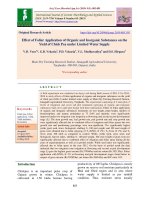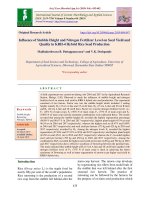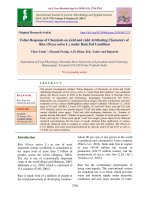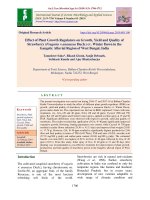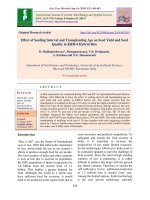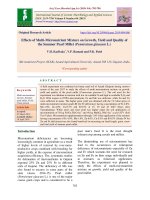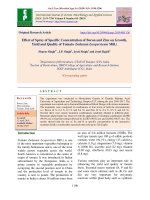Application of manova on some yield attributing characters of groundnut
Bạn đang xem bản rút gọn của tài liệu. Xem và tải ngay bản đầy đủ của tài liệu tại đây (449.65 KB, 11 trang )
Int.J.Curr.Microbiol.App.Sci (2020) 9(3): 2864-2874
International Journal of Current Microbiology and Applied Sciences
ISSN: 2319-7706 Volume 9 Number 3 (2020)
Journal homepage:
Original Research Article
/>
Application of Manova on some Yield Attributing Characters of Groundnut
Jit Sankar Basak*, Ayan Dey, Mriganka Saha and Anurup Majumder
Department of Agricultural Statistics, Bidhanchandra Krishi Viswavidyalaya,
Mohanpur, Nadia, W.B., Pin-741252, India
*Corresponding author
ABSTRACT
Keywords
ANOVA,
Character,
MANOVA
Article Info
Accepted:
22 February 2020
Available Online:
10 March 2020
In most of the agricultural experiments, data on multiple characters is frequently used.
Analysis of variance (ANOVA) technique is employed for assessment of each single
character and the best treatment can be identified on the basis of the performance. But
more than one or at least two characters cannot be taken into account simultaneously.If it
is seen the system as a whole, more than one characters are important to the researcher. In
these situations, Multivariate Analysis of Variance (MANOVA) can be helpful. At first, an
experiment on groundnut was conducted involving 11 treatment and 3 replication in
Randomized Block Design (RBD) setup at District seed farm, Kalyani, BCKV, West
Bengal (22.9878o N, 88.4249o E). Three characters namelynumber of pod per plant, dry
pod weight per plant, dry pod yield are taken in consideration for analysis. Three separate
ANOVAs and a single MANOVA are performed based on three character separately and
simultaneously. At 5% level of significance, based on single character number of pod per
plant, there have no significant difference within treatments. In case of dry pod weight per
plant T5, T6, T3 are statistical at par. Based on single character dry pod yield T4, T3, T5
and T2 are statistical at par. But based on the three character simultaneously, according to
the Wilk’s Lambda criterion T3 is statistical at par with T2, T4 and T5. For treatment
comparison, MANOVA can give better result than ANOVA in presence of multiple
characters.
Introduction
In most of the agricultural experiments, data
on multiple characters is frequently used. The
characters on which the data generally
collected for any experiment are the plant
height, number of green leaves, germination
count, yield values, etc. of the crop under
experiment. Analysis of variance (ANOVA)
technique is employed for assessment of each
single character and the best treatment can be
identified on the basis of the performance.
More than one ANOVA techniques are used
for each of the characters under study and the
best treatment is identified for each individual
character.
But more than one or at least two characters
cannot be taken into account simultaneously.
There may be one treatment ranking first in
case of first character and may not account
rank first for another character. If it is seen
2864
Int.J.Curr.Microbiol.App.Sci (2020) 9(3): 2864-2874
the system as a whole, both the characters are
important to the researcher. Therefore, while
analysing the data say for two characters, both
of the two characters should also be taken into
consideration at a time or in a single method.
In these situations, Multivariate Analysis of
Variance (MANOVA) can be helpful as it
includes more than one character in a single
method.
Actually, MANOVA is an extension of
common analysis of variance (ANOVA).
Games (1990) worked on ANOVA and
MANOVA as an alternative analysis method
for repeater measured designs. Grice (2007)
worked on difference in between MANOVA
and ANOVA and comprehensible set of
methods for explore the multivariate
properties of a data set. Schott (2007) also
worked on high dimensional tests for one-way
MANOVA.
Groundnut is one of the most important
oilseed crop in India. It has different yield
attributing characters, among them number of
pod per plant, dry pod weight per plant, dry
pod yield, etc. are important yield attributing
characters. Taylor and Whelan (2011) worked
on sweet corn for selection of additional data
to develop production management units.
Keeping in mind the importance of
MANOVA
model
for
analysis
of
experimental
observations
in
field
experiments, an attempt has made in the
present piece of study on Groundnut (Arachis
hypogaea) to apply MANOVA model on
three yielding attributing characters of the
crop.
Materials and Methods
An experiment was conducted involving 11
treatment and 3 replication in Randomized
Block Design (RBD) setup at District seed
farm, Kalyani, BCKV, West Bengal(22.9878o
N, 88.4249o E)under the project AICRP on
groundnut (2015-16). Data are collected from
Prof. S. Gunri, In-charge, AICRP on
groundnut.
Three characters namelynumber of pod per
plant, dry pod weight per plant, dry pod yield
are considered for analysis. Table-1
represents 11 treatments as the irrigation
schedule with different depth of irrigation
water. Irrigation given at 15, 30, 40, 50, 65,
80 days after emergence with 20 mm; 30 mm;
40 mm and 50mm depth of irrigation water.
In table-1 bold marked depth of irrigations
were skipped during different crop growth
stages.
ANOVA
The observations can be represented in RBD
(Randomised Block Design) by,
; i = 1,2,…,v ;
j = 1,2,…,r
where,
is the observation due to ith
treatment and jth replication; is the general
mean;
is the effect of ith treatment;
effect of jth replication;
is the
is the error
component associated with
and assumed to
be distributed independently as
.
MANOVA
MANOVA (Multivariate Analysis
of
Variance) is a generalized form of ANOVA
(Univariate Analysis of Variance). It is used
to analyse data that involves more than one
dependent variable at a time.
MANOVA allows us to test hypotheses
regarding the effect of one or more
independent variables on two or more
dependent variables.
2865
Int.J.Curr.Microbiol.App.Sci (2020) 9(3): 2864-2874
Assumption of MANOVA
not equal to 0; i = 1,2,…,v
1. The dependent variable (e.g. grain yield,
straw yield) should be normally distributed
within each groups.
not equal to 0; j = 1,2,…,r
Let,
2. There have linear relationships among all
pairs of dependent variables, all pairs of
covariates (e.g. between grain and straw
yield).
;
;
;
3.Error
component
follows
should
be
;
;
.
;
The observations can be represented in
MANOVA with RBD (Randomised Block
Design) set up with three characters (p = 3) is,
; i = 1,2,…,v ;
j = 1,2,…,r ; p = 1,2,3 ;
where,
is a 3-variate
vector of observations due to ith treatment and
jth replication;
is a 3x1
vector of general means;
are
th
the effect of i treatment on p-character;
are the effect of jth
on
p-characters;
replication
is
a
component associated with
p-variate
and assumed to
and
is the observation due toith treatment
and jth replication corresponding to
pthcharacter.
‘s are equal
the
alternate
MANOVA can be used when the rank of R
matrix should not be smaller than character-p
or in the other words error degrees of freedom
s should be greater than or equal top (e p).
For testing null hypothesis is,
‘s are
equal to 0(i = 1,2,…,v), here 4 test criterias
are used namely Pillai’s Trace, Wilk’s
Lambda statistics ( , Lawley-Hotelling
Trace, Roy’s Largest Root.
Pillai’s trace
Let,
hypothesis
is the eigenvalue of H(R+H)-1 matrix.
The Pillai’strace statistics
‘s are equal to 0 ; j = 1,2,…,r
Against
Table-2 represents MANOVA’s source of
variation, corresponding degree of freedom
(d.f.) and SSCPM (Sum of Squares and Cross
Product Matrix). All symbols used in bold
letters are representing the matrices.Here,H,
B, R, T are 3x3 matrixes ( p = 3).
error
be distributed independently as
The null hypothesis is,
to 0 ; i = 1,2,…,v
;
is,
2866
defined by,
Int.J.Curr.Microbiol.App.Sci (2020) 9(3): 2864-2874
Here,
defined by,
;
Here,
;
;
where,
where, s = min(p,h) ;
;
s = min(p , h) ; a = ph ; b =
;
;
If calculated value of
then
is rejected at α % level of
significance, otherwise it is accepted.
Roy’s Largest root
Wilk’s lambda statistics (
The Wilk’s Lambda statistics (
by,
.
For
any
p
is defined
and
Let,
is the eigenvalue of HR-1 matrix and
Roy’s largest root (
is defined by the
largest value in the
’s. Here,
;
h,
;
where, s = min (p,h) ;
where, |R| and |H+R| represent the
determinant value of matrix R and (H+R)
respectively;
;b=
If calculated value of
then
is
rejected at α % level of significance,
Otherwise it is accepted.
If
calculated
;
value
of
then
is
rejected at α % level of significance,
Otherwise it is accepted.
;
Wilk’s lambda criterion
If
calculated
value
of
then
is
rejected at α % level of significance,
Otherwise it is accepted.
Lawley-Hotelling trace
Let,
is the eigenvalue of HR-1 matrix. The
Lawley-Hotelling trace statistics (
Suppose the null hypothesis is,
;
against
the
alternate
hypothesis
is,
;
.For
testing the null hypothesis for each pair of
treatment, another SSCPM have to calculate.
Let,
this
SSCPM
is
denoted
by
. The diagonal elements of
the matrix is obtained by,
is
and off diagonal
2867
Int.J.Curr.Microbiol.App.Sci (2020) 9(3): 2864-2874
elements
are
obtained
by,
; k =
1,2,3 ;
Results and Discussion
.
Then the Wilk’s Lambda (
) is defined by,
;
where, |R| and |G+R| represent the
determinant value of matrix R and (H+R)
respectively. Here,
.
If
calculate.
calculated
value
of
then
is
rejected at α % level of significance,
Otherwise it is accepted. For Compare in
between each pair of treatment[(1,2),
(1,3),…,(1,v),(2,3),…,(2,v),… (v-1,v)], each
new
matrix time have to calculate. In
case of v number of treatments,
numbers of
matrixes and
have to
The table-3 represents ANOVA table for the
character number of pod per plant. For the
replication effect there have significant
difference at 5% level of significance but for
the treatment effect there have no significant
difference at 5% level of significance. Table-4
represents treatment means for the character
number of pod per plant. Due to nonsignificance of treatment effect, there have no
grouping for the character number of pod per
plant. Here, table-5 represents ANOVA table
for the character dry pod weight per plant.
Replication effect and treatment effect both
are significant 5% level of significance and
null hypothesis is rejected. Table-6 represents
treatment means and grouping for the
character dry pod weight per plant. For the
character dry pod weight per plant 4 number
of groups are identified. T5 is the best
treatment and it statistical at per with T6 and
T3. T10 is the worse treatment.
Table.1 Treatments representing the irrigation schedule and different depth of irrigation water
Treatmen
t
T1
T2
T3
T4
15
DAE
20
30
40
50
30
DAE
20
30
40
50
T5
T6
T7
T8
T9
T10
T11
20
20
20
20
20
20
20
20
20
20
20
20
20
20
Irrigation days after emergence
40
50
65
DAE
DAE
DAE
20
20
20
30
30
30
40
40
40
50
50
50
30
30
30
30
30
30
30
2868
30
30
30
30
30
30
30
40
40
40
40
40
40
40
80
DAE
20
30
40
50
40
40
40
40
40
40
40
Int.J.Curr.Microbiol.App.Sci (2020) 9(3): 2864-2874
Table.2 Manova
Source of
variation
Treatment
v-1 = h
Replication
r-1 = t
Error
Total
d.f.
SSCPM (Sum of Squares and Cross Product Matrix)
(v-1) (r-1)
=e
X
vr-1
=H+
B+ R
Table.3 ANOVA for the character number of pod per plant
Source of
variation
Replication
Treatment
Error
Total
d.f.
2
10
20
32
Sum of
Squares
75.975
104.783
105.672
286.43
Mean
Square
37.988
10.478
5.284
Calculated
F value
7.19
1.983
Sig.(Pr.>F)
0.004
0.092
Table.4 Treatment means for the character number of pod per plant
Treatment
T5
T6
T3
T1
T4
T2
T7
T8
T11
T9
T10
2869
Mean
40.700
36.100
36.067
34.067
33.267
32.900
32.300
29.867
29.700
29.367
27.467
Int.J.Curr.Microbiol.App.Sci (2020) 9(3): 2864-2874
Table.5 ANOVA for the character dry pod weight per plant
Source of
variation
Replication
Treatment
d.f.
2
10
Sum of
Squares
12661.31
433.227
Mean
Square
6330.655
43.323
Error
20
214.069
10.703
Total
32
13308.61
Calculated
F value
591.459
4.048
Sig.(Pr.>F)
0.000
0.004
Table.6 Treatment means and grouping for the character dry pod weight per plant
Treatment
Mean
Grouping
T5
40.700
A
T6
36.100
A
B
T3
36.067
A
B
T1
34.067
B
C
T4
33.267
B
C
D
T2
32.900
B
C
D
T7
32.300
B
C
D
T8
29.867
B
C
D
T11
29.700
C
D
T9
29.367
C
D
T10
27.467
D
Table.7 ANOVA for the character dry pod yield
Source of
variation
d.f.
Sum of
Squares
Mean
Square
Calculated
F value
Sig.(Pr.>F)
Replication
2
126678.727
63339.364
2.567
0.102
Treatment
10
4690474.909
469047.491
19.013
0.000
Error
Total
20
32
493403.273
5310556.909
24670.164
2870
Int.J.Curr.Microbiol.App.Sci (2020) 9(3): 2864-2874
Table.8 Treatment means and grouping for the character dry pod yield
Treatment
T4
T3
T5
T2
T11
T6
T7
T1
T10
T8
T9
Mean
4205
4189
4133
3937
3896
3789
3678
3611
3302
3189
3099
Grouping
A
A
A
A
B
C
C
D
E
E
E
B
B
C
D
D
C
D
Table.9 MANOVA
Source
d.f.
Treatment
10
Replication
2
Error
20
Total
32
SSCPM (Sum of Squares and Cross Product Matrix)
= H + B+ R
Table.10 MANOVA test criteria and F approximations for the hypothesis
of no overall treatment effect
Effect
Treatment
Test criteria
Statistic
value
1.519
F-table
value
2.051
Sig.(Pr.>F)
Wilks' Lambda
0.033
3.909
0.000
Lawley-Hotelling's Trace
14.297
7.943
0.000
Roy's Largest Root
13.325
26.651
0.000
Pillai's Trace
2871
0.009
Int.J.Curr.Microbiol.App.Sci (2020) 9(3): 2864-2874
Table.11 Wilk’s Lambda criterion statistics (
Treatment
1
2
3
4
for all possible treatmentpair comparison
5
6
7
8
9
10
11
1
2
0.754
3
0.454
0.744
4
0.472
0.797
0.940
5
0.400
0.580
0.857
0.719
6
0.850
0.882
0.652
0.653
0.600
7
0.971
0.808
0.475
0.513
0.399
0.842
8
0.533
0.325
0.198
0.210
0.177
0.353
0.511
9
0.436
0.272
0.171
0.180
0.153
0.292
0.417
0.954
10
0.556
0.356
0.212
0.232
0.185
0.376
0.563
0.901
0.800
11
0.758
0.900
0.575
0.670
0.436
0.775
0.858
0.372
0.308
0.437
Table.12 Probability of significance(Pr. >F) of all possible treatment paircomparison using
Wilk’s Lambda criterion statistics (
Treatment
1
2
3
4
5
6
7
8
9
10
11
1
2
0.157
3
0.002
0.141
4
0.003
0.240
0.767
5
0.001
0.018
0.414
0.108
6
0.392
0.510
0.048
0.049
0.024
7
0.909
0.269
0.003
0.006
0.001
0.364
8
0.009
0.000
0.000
0.000
0.000
0.000
0.006
9
0.002
0.000
0.000
0.000
0.000
0.000
0.001
0.831
10
0.013
0.000
0.000
0.000
0.000
0.000
0.014
0.588
0.248
11
0.163
0.584
0.017
0.061
0.002
0.195
0.419
0.000
0.000
Table.7 represents ANOVA table for the
character dry pod yield. For the replication
effect there have non-significant difference at
5% level of significance but for the treatment
effect there have significant difference at 5%
level of significance. Table-8 represents
treatment means and grouping for the
character dry pod yield. For the character dry
0.002
pod yield, 5 number of groups are identified.
Based on this character T4 is the best
treatment and it statistical at par with T3, T5
and T2. T9 is the worse treatment. Now, the
above three characters are analyzed together
by using MANOVA model (as in 2.5). Table9 represents MANOVA. H, B, R, Tall are 3x3
matrices denoted by bold characters. Table-10
2872
Int.J.Curr.Microbiol.App.Sci (2020) 9(3): 2864-2874
represents MANOVA test criteria and F
approximations for the hypothesis of no
overall treatment effect. Here, Pillai's Trace,
Wilks' Lambda, Lawley-Hotelling's Trace and
Roy's Largest Root all are significant at 5%
level of significance means there have
significance in between treatment’s mean
vectors. Table-11 represents Wilk’s Lambda
criterion statistics (
for for all possible
treatment pair comparison (55 treatment
pairs) and table-12 represents probability of
significance (Pr. >F)of all possible paired
treatment comparison using Wilk’s Lambda
criterion statistics (
Here, bold numbers
are represents the treatment pairs those are not
significantly differ at 5% level of
significance.
Based on single character number of pod per
plant, there have no significant difference
within treatments at 5% level of significance.
But comparison using single character dry
pod weight per plant, treatments T5, T6, T3
are statistical at par and all of those are best
treatment. Based on single character dry pod
yield, treatments T4, T3, T5 and T2 are
statistical at par. But based on the three
character simultaneously, according to the
Wilk’s Lambda criterion T3 is statistical at
par with T2, T4 and T5. So, it can be
concluded that, for treatment comparison,
MANOVA can give better result than
ANOVA in presence of multiple characters.
References
Games, P. A. 1990. Alternative analyses of
repeated-measure designs by ANOVA
and MANOVA. In Statistical methods
in longitudinal research, Academic
Press. Pp. 81-121.
Grice, J. W., and Iwasaki, M. 2007. A truly
multivariate
approach
to
MANOVA. Applied
Multivariate
Research. 12(3): 199-226.
Johnson, R.A. and Wichern, D.W. 1988.
Applied
Multivariate
Statistical
Analysis, Second Edition. Prentice-Hall
International, Inc., London.
Marcoulides, G. A., and Hershberger, S. L.
2014. Multivariate statistical methods:
A first course. Psychology Press.
Oteng-Frimpong, R., Konlan, S. P., and
Denwar, N. N. 2017. Evaluation of
selected groundnut (Arachishypogaea
L.) lines for yield and haulm nutritive
quality traits. International Journal of
Agronomy.
Parsad, R., Gupta, V.K., Batra, P.K.,
Srivastava, R., Kaur, R., Kaur, A. and
Arya, P. 2004. A diagnostic study of
design
and
analysis
of
field
experiments. Project Report, IASRI,
New Delhi.
Patel, S., and Bhavsar, C. D. 2013. Analysis
of pharmacokinetic data by Wilk’s
lambda (An important tool of
MANOVA). International Journal of
Pharmaceutical Science Invention. 2(1):
36-44.
Rao, C.R. 1973. Linear Statistical Inference
and Application. Wiley Eastern Ltd.,
New Delhi.
Seber,
G.A.F.
1983.
Multivariate
Observations.
Wiley
series
in
Probability and Statistics.
Schott, J. R. 2007. Some high-dimensional
tests for a one-way MANOVA. Journal
of Multivariate Analysis. 98(9): 18251839.
Taylor, J. A., and Whelan, B. M. 2011.
Selection of ancillary data to derive
production management units in sweet
corn (Zea Mays var. rugosa) using
MANOVA
and
an
information
criterion. Precision Agriculture. 12(4):
519-533.
2873
Int.J.Curr.Microbiol.App.Sci (2020) 9(3): 2864-2874
How to cite this article:
Jit Sankar Basak, Ayan Dey, Mriganka Saha and Anurup Majumder. 2020. Application of
Manova on some Yield Attributing Characters of Groundnut. Int.J.Curr.Microbiol.App.Sci.
9(03): 2864-2874. doi: />
2874

